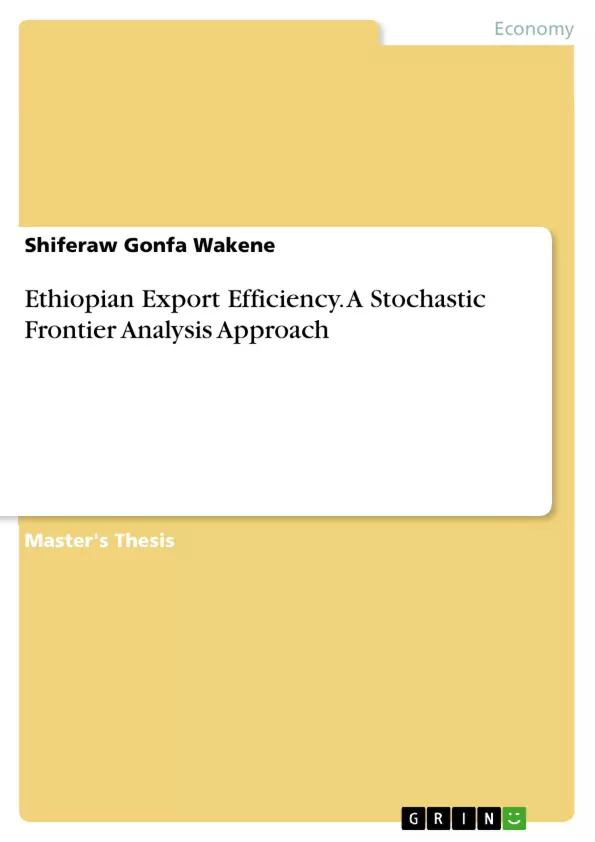This study is conducted to investigate Ethiopian exports efficiency by using a stochastic frontier analysis model with panel data to estimate if countries operated at the frontier with its major trading partners. Export efficiency is defined as the ratio of actual exports to the maximum possible volume. In addition, the study investigates the factors of export efficiency, focusing on Ethiopia’s exports to its major trading partners during the period 2006 to 2017. The arable land, gross domestic product and population of Ethiopia and of the trade partner’s countries, distance between Ethiopia and trade partners’ countries, gross capital formation, and geographical location of trade partner’s countries determines the export flows of Ethiopian export.
As a result the estimated coefficient of determinants shows that population and gross domestic product have significantly and positively affect the Ethiopian export sector. The empirical results show that the volume of Ethiopian actual exports is far below the estimated efficient level, and that there is considerable room for increasing Ethiopia’s exports. The trend of agricultural export efficiency shows some improvement over the stated years while manufacturing sector shows decreases. Those findings imply that Ethiopia should search the redemption policy that enables the country to maximize the efficiency of the sector by using all possible potential.
Inhaltsverzeichnis (Table of Contents)
- ACKNOWLEDGEMENTS
- TABLE OF CONTENTS
- LIST OF TABLES
- LIST OF FIGURES
- LIST OF APPENDICES
- LIST OF ACRONYMS/ABBREVIATIONS
- ABSTRACT
- CHAPTER ONE
- INTRODUCTION
- Background of the Study
- Overview of Ethiopian Export Structure and Its Performance
- Statement of the Problem
- Objective of the Study
- Specific objectives of the Study
- Research Questions
- Hypothesis of the study
- Scope of the study
- Significance of the study
- Limitation of study
- Organization of the Paper
- CHAPTER TWO
- LITERATURE REVIEW
- Theoretical Review
- Mercantilist's View on Export
- Classical Trade Theory and Export
- Export as Heckscher -Ohlin Theory
- Empirical Review
- TRADE EFFICIENCY AND ITS DETERMINANTS
- MEASUREMENT OF EXPORT EFFICIENCY
- Conceptual Framework
- CHAPTER THREE
- METHODOLOGY OF THE STUDY
- Research Approach
- Research Techniques
- Sample Design
- Data Source and Data Type
- Definitions of variables
- Research Design
- Model Specification
- Model Estimation
- Stochastic Frontier Analysis (SFA) Model
- Export Efficiency Measurement
- CHAPTER FOUR
- DISCUSSION AND ANALYSIS
- Data Discussion
- Result Discussion
- Trade Flows (Exports) from Ethiopia to its Major Trading Partners
- Agricultural product Exports from Ethiopia to its Major Trading Partners
- Manufacturing Exports from Ethiopia to its Major Trading Partners
- Estimated Export Efficiency
- CHAPTER FIVE
- CONCLUSION AND RECOMMENDATION
- CONCLUSION
- RECOMMENDATION
- REFERENCE
- APPENDIX
Zielsetzung und Themenschwerpunkte (Objectives and Key Themes)
This study aims to assess the efficiency of Ethiopian exports using a Stochastic Frontier Analysis (SFA) approach. The study analyzes the factors affecting export performance and identifies potential areas for improvement.
- Analyzing the determinants of export efficiency in Ethiopia.
- Examining the impact of various factors on export performance.
- Assessing the efficiency of different export sectors in Ethiopia.
- Providing recommendations for enhancing export competitiveness.
- Contributing to the understanding of export dynamics in developing countries.
Zusammenfassung der Kapitel (Chapter Summaries)
Chapter One introduces the background of the study, outlining the current state of Ethiopian exports and highlighting key issues. The chapter also defines the research problem, objectives, questions, hypothesis, scope, significance, limitations, and organization of the paper. Chapter Two reviews relevant literature on export efficiency, exploring theoretical perspectives and empirical studies. It examines different theories of trade and their implications for export performance, focusing on efficiency measurement methods. The chapter also presents the conceptual framework guiding the research. Chapter Three details the research methodology employed, covering the approach, techniques, sample design, data sources, variable definitions, and model specification. It explains the application of the SFA model and the methodology for measuring export efficiency. Chapter Four presents the discussion and analysis of the results obtained from the study. The chapter explores data trends, examines the relationship between various factors and export performance, and analyzes the estimated export efficiency levels.
Schlüsselwörter (Keywords)
This research focuses on the key topics of export efficiency, Ethiopian exports, Stochastic Frontier Analysis (SFA), trade efficiency determinants, and export competitiveness. It utilizes empirical data and analysis to assess the performance of different export sectors in Ethiopia and identify areas for improvement.
- Quote paper
- Shiferaw Gonfa Wakene (Author), 2018, Ethiopian Export Efficiency. A Stochastic Frontier Analysis Approach, Munich, GRIN Verlag, https://www.grin.com/document/986216



